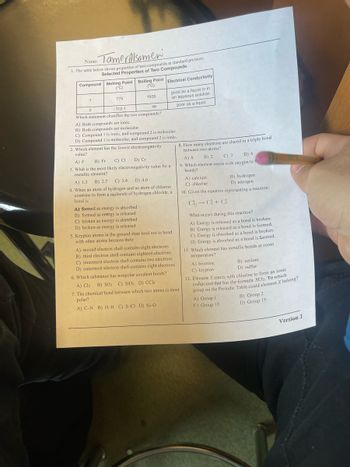
Applications and Investigations in Earth Science (9th Edition)
9th Edition
ISBN: 9780134746241
Author: Edward J. Tarbuck, Frederick K. Lutgens, Dennis G. Tasa
Publisher: PEARSON
expand_more
expand_more
format_list_bulleted
Question
Helping

Transcribed Image Text:Name:
Tamer Alsomen
1. The table below shows properties of two compounds at standard pressure.
Selected Properties of Two Compounds
Compound Melting Point Boiling Point
(°C)
(°C)
1935
1
775
2
-112.1
46
Which statement classifies the two compounds?
A) Both compounds are ionic.
B) Both compounds are molecular.
C) Compound 1 is ionic, and compound 2 is molecular.
D) Compound 1 is molecular, and compound 2 is ionic:
2. Which element has the lowest electronegativity
value?
Electrical Conductivity
good as a liquid or in
an aqueous solution
poor as a liquid
A) F
B) Fr C) CI D) Cr
3. What is the most likely electronegativity value for a
metallic element?
A) 1.3 B) 2.7
C) 3.4
D) 4.0
4. When an atom of hydrogen and an atom of chlorine
combine to form a molecule of hydrogen chloride, a
bond is
A) formed as energy is absorbed
B) formed as energy is released
C) broken as energy is absorbed
D) broken as energy is released
5. Krypton atoms in the ground state tend not to bond
with other atoms because their
A) second electron shell contains eight electrons
B) third electron shell contains eighteen electrons
C) innermost electron shell contains two electrons
D) outermost electron shell contains eight electrons
6. Which substance has nonpolar covalent bonds?
A) Cl2 B) SO3 C) SiO2 D) CCl4
8. How many electrons are shared in a triple bond
between two atoms?
A) 6
D) 4
B) 2 C) 3
9. Which element reacts with oxygen to f
bonds?
7. The chemical bond between which two atoms is most
polar?
A) C-N B) H-H C) S-CI D) Si-O
B) hydrogen
D) nitrogen
10. Given the equation representing a reaction:
Cl₂ →Cl + Cl
A) calcium
C) chlorine
What occurs during this reaction?
A) Energy is released as a bond is broken.
B) Energy is released as a bond is formed.
C) Energy is absorbed as a bond is broken.
D) Energy is absorbed as a bond is formed.
11. Which element has metallic bonds at room
temperature?
A) bromine
C) krypton
B) cesium
D) sulfur
12. Element Y reacts with chlorine to form an ionic
compound that has the formula XCI₂. To which
group on the Periodic Table could element X belong?
A) Group I
C) Group 13
B) Group 2
D) Group 15
Version 1
Expert Solution
arrow_forward
Explanation:
"Since you have asked multiple questions, we will solve the first question for you. If you want any specific question to be solved then please specify the question number or post only that question."
Compound 1 has a very high melting and boiling point, while Compound 2 has a very low melting and boiling point. Likewise, although Compound 2 has low electrical conductivity as a liquid, Compound 1 exhibits strong electrical conductivity both as a liquid and in an aqueous solution. These characteristics point to Compound 1 being most likely ionic and Compound 2 being most likely molecular.
Therefore, the correct answer is C) Compound 1 is ionic, and compound 2 is molecular.
Trending nowThis is a popular solution!
Step by stepSolved in 2 steps

Knowledge Booster
Recommended textbooks for you
 Applications and Investigations in Earth Science ...Earth ScienceISBN:9780134746241Author:Edward J. Tarbuck, Frederick K. Lutgens, Dennis G. TasaPublisher:PEARSON
Applications and Investigations in Earth Science ...Earth ScienceISBN:9780134746241Author:Edward J. Tarbuck, Frederick K. Lutgens, Dennis G. TasaPublisher:PEARSON Exercises for Weather & Climate (9th Edition)Earth ScienceISBN:9780134041360Author:Greg CarbonePublisher:PEARSON
Exercises for Weather & Climate (9th Edition)Earth ScienceISBN:9780134041360Author:Greg CarbonePublisher:PEARSON Environmental ScienceEarth ScienceISBN:9781260153125Author:William P Cunningham Prof., Mary Ann Cunningham ProfessorPublisher:McGraw-Hill Education
Environmental ScienceEarth ScienceISBN:9781260153125Author:William P Cunningham Prof., Mary Ann Cunningham ProfessorPublisher:McGraw-Hill Education Earth Science (15th Edition)Earth ScienceISBN:9780134543536Author:Edward J. Tarbuck, Frederick K. Lutgens, Dennis G. TasaPublisher:PEARSON
Earth Science (15th Edition)Earth ScienceISBN:9780134543536Author:Edward J. Tarbuck, Frederick K. Lutgens, Dennis G. TasaPublisher:PEARSON Environmental Science (MindTap Course List)Earth ScienceISBN:9781337569613Author:G. Tyler Miller, Scott SpoolmanPublisher:Cengage Learning
Environmental Science (MindTap Course List)Earth ScienceISBN:9781337569613Author:G. Tyler Miller, Scott SpoolmanPublisher:Cengage Learning Physical GeologyEarth ScienceISBN:9781259916823Author:Plummer, Charles C., CARLSON, Diane H., Hammersley, LisaPublisher:Mcgraw-hill Education,
Physical GeologyEarth ScienceISBN:9781259916823Author:Plummer, Charles C., CARLSON, Diane H., Hammersley, LisaPublisher:Mcgraw-hill Education,

Applications and Investigations in Earth Science ...
Earth Science
ISBN:9780134746241
Author:Edward J. Tarbuck, Frederick K. Lutgens, Dennis G. Tasa
Publisher:PEARSON

Exercises for Weather & Climate (9th Edition)
Earth Science
ISBN:9780134041360
Author:Greg Carbone
Publisher:PEARSON

Environmental Science
Earth Science
ISBN:9781260153125
Author:William P Cunningham Prof., Mary Ann Cunningham Professor
Publisher:McGraw-Hill Education

Earth Science (15th Edition)
Earth Science
ISBN:9780134543536
Author:Edward J. Tarbuck, Frederick K. Lutgens, Dennis G. Tasa
Publisher:PEARSON

Environmental Science (MindTap Course List)
Earth Science
ISBN:9781337569613
Author:G. Tyler Miller, Scott Spoolman
Publisher:Cengage Learning

Physical Geology
Earth Science
ISBN:9781259916823
Author:Plummer, Charles C., CARLSON, Diane H., Hammersley, Lisa
Publisher:Mcgraw-hill Education,